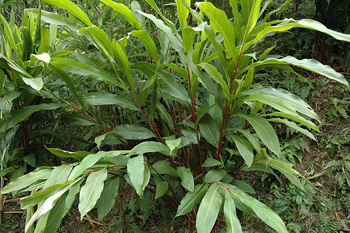Contents:
Common Names | Parts Usually Used | Plant(s) & Culture | Where Found | Medicinal Properties | Biochemical Information
Legends, Myths and Stories | Uses | Formulas or Dosages | Warning | Bibliography
Scientific Names

- Elettaria cardamomum L.
- Zingiberaceae/
- Ginger family
Common Names
- Bastard cardamom
- Cardamom seeds
- Cardamon
- Ela (Sanskrit name)
- Malabar cardamom
- Sha-ren (Chinese name)
Parts Usually Used
Seed
Back to Top
Description of Plant(s) and Culture

Cardamom is a perennial plant; the simple, erect stems grow to a height of 6-10 feet from a thumb-thick, creeping rootstock. The leaves are lanceolate, dark green and glabrous above, lighter and silky beneath. The small, yellowish flowers grow in loose racemes on prostrate flower stems. The fruit is a three-celled capsule holding up to 18 seeds.
Back to Top
Where Found
Found commonly in southern India but also cultivated in other tropical areas.
Back to Top
Medicinal Properties
Appetizer, carminative, diaphoretic, expectorant, stimulant, stomachic
Back to Top
Biochemical Information
Essential oil including D-borneol, bornylacetate, d-camphor, nerolidol, linalool
Back to Top
Legends, Myths and Stories
A seed pod with an exotic fragrance of the Far East where it is used in curries and many Oriental dishes. Arabians and Persians steep a cardamom pod in their coffee after it has been brewed for its agreeable aroma and flavor. The French use it in their demi-tasse.
Cardamom added to milk neutralizes its mucus forming properties and it detoxifies caffeine in coffee.
Cardamom is an ingredient in Christmas cookies, Danish and Swedish cookies, coffee cakes, pastries, and candies. It adds a delightful essence to applesauce, sliced oranges, grape jelly, fruit salads, spiced wines, and liqueurs.
One lady in 1854 wrote, “ In our young days, we recollect seeing ladies carry cardamoms in their pockets, and eat them as if they were sweetmeats.”
In Europe, the seeds are sometimes seen in fancy dishes in cocktail lounges and bars. The seeds are also used in potpourri, sachets, and sweet-scented mixtures.
A natural perfume of the vegetable kingdom; the seeds were often an ingredient of old-time love potions.
Seeds come from the dried fruit of the cardamom plant, found in India and other tropical areas. Their flavor is slightly gingerish, leaving a medicinal aftertaste. Used in Mexican, Spanish, and East Indian dishes.
A mild stimulant, cardamom is a standard ingredient of curry.
Cardamom is a relative of the ginger family and a native to the Orient. Old-fashioned sweet bags, perfume powders, and incense contained cardamom seeds. Oil of cardamom is used to make Lily-of-the-valley perfume.
It is said the Syrians used 1 or 2 cardamom seeds with coffee.
Back to Top
Uses
According to a Chinese Materia Medica, a tea made from cardamom seeds will counteract acidity of the stomach, stimulate digestion because cardamom contains a large amount of volatile oil, and relieves discomfort of flatulence. Treats gastralgia, enuresis (involuntary urination), spermatorrhea, phlegm, colds, cough, bronchitis, asthma, hoarse throat, kidney diseases. In Turkey, 1 or 2 cardamom seeds are chewed to sweeten the breath and to conceal liquor breath.
Seeds are used as a spice in cooking and as a flavoring in other medicines.
Back to Top
Formulas or Dosages
For indigestion, mix 15 pulverized seeds in 1/2 cup hot water. Add 1 oz. of fresh gingerroot and a cinnamon stick. Simmer 15 minutes over low heat. Add 1/2 cup milk and simmer 10 more minutes. Add 2 or 3 drops of vanilla. Sweeten with honey. Drink 1 to 2 cups daily.
Back to Top
Warning
Care should be taken if internally ulcers are present. Consult medical supervision.
Back to Top
Bibliography
![]() The Herb Book
The Herb Book, by John Lust, Bantam Books, 666 Fifth Avenue, New York, NY. copyright 1974.
![]() Planetary Herbology
Planetary Herbology, by Michael Tierra, C.A., N.D., O.M.D., Lotus Press, PO Box 325, Twin Lakes. WI 53181., Copyright 1988, published 1992
![]() American Folk Medicine
American Folk Medicine, by Clarence Meyer, Meyerbooks, publisher, PO Box 427, Glenwood, Illinois 60425, 1973
 Earl Mindell’s Herb Bible
Earl Mindell’s Herb Bible, by Earl Mindell, R.Ph., Ph.D., Simon & Schuster/Fireside, Rockefeller Center 1230 Avenue of the Americas, New York, New York 10020
![]() Indian Herbalogy of North America
Indian Herbalogy of North America, by Alma R. Hutchens, Shambala Publications, Inc., Horticultural Hall, 300 Massachusetts Avenue, Boston, Massachusetts 02115, 1973
 Old Ways Rediscovered
Old Ways Rediscovered, by Clarence Meyer, Meyerbooks, publisher, PO Box 427, Glenwood, Illinois 60425, published from 1954, print 1988
![]() Webster’s New World Dictionary
Webster’s New World Dictionary, Third College Edition, Victoria Neufeldt, Editor in Chief, New World Dictionaries: A Division of Simon & Schuster, Inc., 15 Columbus Circle, New York, NY 10023
 The Magic of Herbs in Daily Living
The Magic of Herbs in Daily Living, by Richard Lucas, Parker Publishing Co. (1988).
![]() The Herbalist Almanac
The Herbalist Almanac, by Clarence Meyer, Meyerbooks, publisher, PO Box 427, Glenwood, Illinois 60425, copyright 1988, fifth printing, 1994
![]() The Yoga of Herbs: An Ayurvedic Guide to Herbal Medicine
The Yoga of Herbs: An Ayurvedic Guide to Herbal Medicine, by Dr. David Frawley & Dr. Vasant Lad, Lotus Press, Twin Lakes, Wisconsin, Second edition, 1988.
 The Rodale Herb Book: How to Use, Grow, and Buy Nature’s Miracle Plants (An Organic gardening and farming book)
The Rodale Herb Book: How to Use, Grow, and Buy Nature’s Miracle Plants (An Organic gardening and farming book), edited by William H. Hylton, Rodale Press, Inc. Emmaus, PA, 18049., 1974
